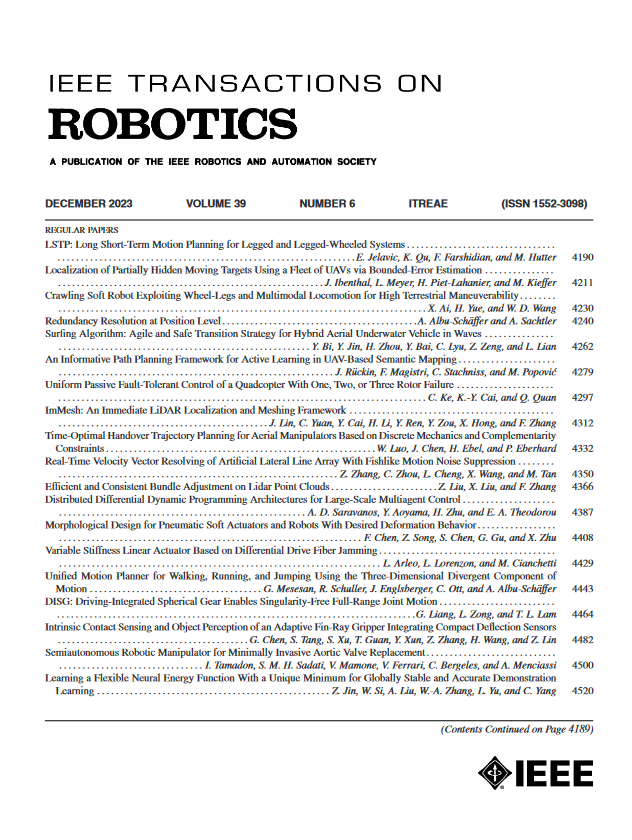Integrating Contact-Aware CPG System for Learning-Based Soft Snake Robot Locomotion Controllers
IF 9.4
1区 计算机科学
Q1 ROBOTICS
引用次数: 0
Abstract
Contact-awareness poses a significant challenge in the locomotion control of soft snake robots. This article is to develop bioinspired contact-aware locomotion controllers, grounded in a novel theory pertaining to the feedback mechanism of the Matsuoka oscillator. This mechanism enables the Matsuoka central pattern generator (CPG) system to function analogously to a “spinal cord” in the entire contact-aware control framework. Specifically, it concurrently integrates stimuli, such as tonic input signals originating from the “brain” (a goal-tracking locomotion controller) and sensory feedback signals from the “reflex arc” (the contact reactive controller), for generating different types of rhythmic signals to orchestrate the movement of the soft snake robot traversing through densely populated obstacles and even narrow aisles. Within the “reflex arc” design, we have designed two distinct types of contact reactive controllers: 1) a reinforcement learning-based sensor regulator that learns to modulate the sensory feedback inputs of the CPG system, and 2) a local reflexive controller that establishes a direct connection between sensor readings and the CPG's feedback inputs, adhering to a specific topological configuration. These two reactive controllers, when combined with the goal-tracking locomotion controller and the Matsuoka CPG system, facilitate the implementation of two contact-aware locomotion control schemes. Both control schemes have been rigorous tested and evaluated in both simulated and real-world soft snake robots, demonstrating commendable performance in contact-aware locomotion tasks. These experimental outcomes further validate the benefits of the modified Matsuoka CPG system, augmented by a novel sensory feedback mechanism, for the design of bioinspired robot controllers.求助全文
约1分钟内获得全文
求助全文
来源期刊

IEEE Transactions on Robotics
工程技术-机器人学
CiteScore
14.90
自引率
5.10%
发文量
259
审稿时长
6.0 months
期刊介绍:
The IEEE Transactions on Robotics (T-RO) is dedicated to publishing fundamental papers covering all facets of robotics, drawing on interdisciplinary approaches from computer science, control systems, electrical engineering, mathematics, mechanical engineering, and beyond. From industrial applications to service and personal assistants, surgical operations to space, underwater, and remote exploration, robots and intelligent machines play pivotal roles across various domains, including entertainment, safety, search and rescue, military applications, agriculture, and intelligent vehicles.
Special emphasis is placed on intelligent machines and systems designed for unstructured environments, where a significant portion of the environment remains unknown and beyond direct sensing or control.
 求助内容:
求助内容: 应助结果提醒方式:
应助结果提醒方式:


